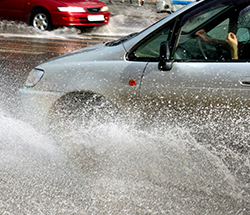
It's been two years since flooding in Toronto caused more than $850 million in property damages.
It was July 8, 2013 when a storm dumped 126 millimetres of rain on the city. The storm caused flooding under bridges and throughout the city, destroyed power lines, triggered outages for some 300,000 Torontonians, shut down subways, and wreaked havoc on basements and homes across town. It was a nightmare for homeowners and insurers alike.
The Insurance Bureau of Canada called it the province's most costly natural disaster. Combined with Alberta's floods, which cost more than $1.7 billion in insured damages and billions more in uninsured damage, 2013 was a defining year for home insurance, and one that forced insurers to re-evaluate how flood-related damage is treated and covered.
A Snapshot of Flood Insurance in 2013
At that point in time, overland flood insurance-which consists of flooding caused by an overflow from a body of water, or accumulated surface water caused by heavy rain-wasn't something that existed.
Many homeowners in Alberta and Ontario were horrified to discover certain damages were not covered under their home insurance policy. The only related insurance that existed was sewer back-up insurance, an optional add on that covers homeowners in the event municipal drainage systems overflow and send water into a home.
But now, several home insurance providers are beginning to consider, and in some cases offer, overflow flood coverage that's never been available to homeowners before.
Changes To Flood Coverage in Ontario
The Co-operators, Aviva and a handful of independent insurance providers first responded to the Calgary flood by offering coverage packages that protect homeowners from damage caused by extreme rainfall or overflowing water banks such as rivers and lakes. These packages began to roll out in 2014.
Now, Aviva's offering is also available to homeowners and tenants in Ontario. While it is the only company to make this coverage available in the province, there have been reports of a few companies (including Co-operators) considering making similar coverage options available nation-wide.
Overland flood coverage is not available as a stand-alone add-on and must be purchased alongside sewer back-up insurance. Sewer back-up insurance can still be purchased independent of overland flood insurance.
Future of Flood Insurance
As weather patterns continue to worsen over the years, insurers will be forced to continue to adapt. This may mean changes to your home insurance going forward, both in terms of new product offerings and reduced coverage options. Always read your policy to ensure you know exactly what you're covered for in the event of a flood or extreme weather.
- Related Read: 5 Insurance Trends To Watch For In 2015
Have You Compared Rates Lately?
When extreme weather causes this much damage, it can have an impact on everyone's home insurance rates, as many consumers in Alberta and Ontario saw when they were hit with surprise rate increases upon renewal last year.
If you saw your rates climb, or if you feel like you're overpaying on your home insurance, compare home insurance rates today to ensure you're still getting the best rate.




